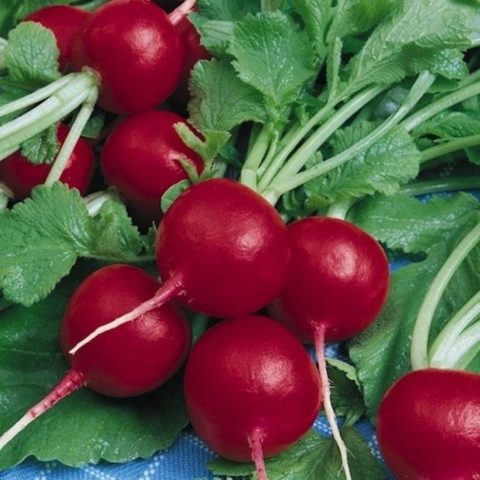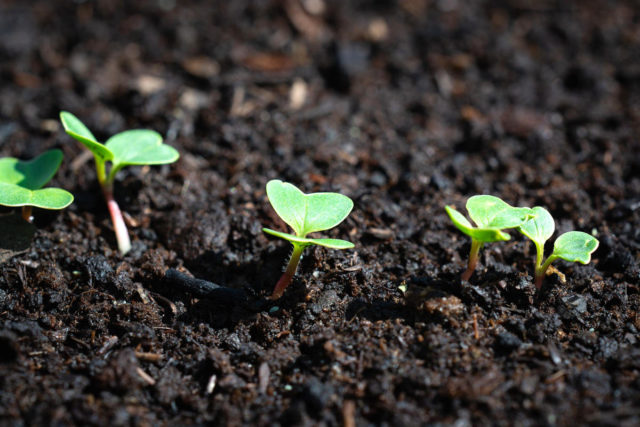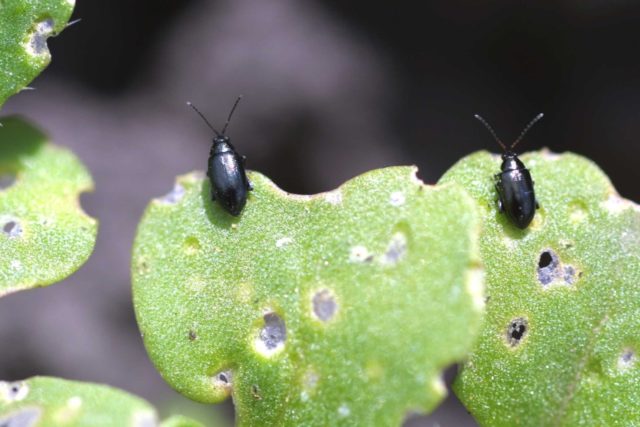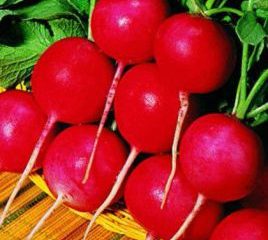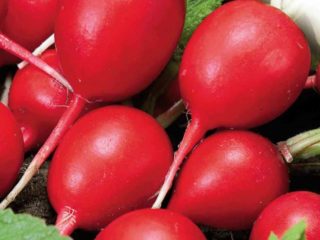Content
Diego radish is one of the most common varieties of this crop, which was known to Europeans even before the advent of potatoes. The vegetable is distinguished not only by its taste, but also by its ease of cultivation.
Description of the radish variety Diego
Diego radish is a hybrid early-ripening Dutch variety that can be easily grown not only in greenhouses, but also in open ground. The F1 marking indicates that the variety is a hybrid, and therefore more resistant to various diseases. Therefore, an increasing number of gardeners are choosing this species for cultivation on their plots.
Main characteristics
Diego is a variety of radish that has very large root vegetables, the size of which reaches 5 cm in diameter, and the weight varies within 60 g. The root vegetables, painted in a bright red, almost burgundy color, are distinguished by their taste:
- juiciness;
- lack of bitter taste;
- white flesh;
- nice crunch.
Productivity
Radish Diego F1, according to reviews, is a high-yielding variety. Germination is 99%, and even unfavorable weather conditions do not have much impact on the yield.Therefore, the amount of harvest depends entirely on the scale of planting of this vegetable.
No less important is the fact that Diego is an early ripening variety: only 20 - 30 days pass from the moment of sowing and harvesting.
Advantages and disadvantages
Understanding gardeners know that each plant has its own advantages and disadvantages. The only disadvantage of the Diego variety is the fact that vegetable seeds are slightly more expensive than varietal seeds. Otherwise, Diego has only positive qualities:
- cold resistance;
- unpretentiousness in cultivation;
- short ripening period;
- high productivity;
- possibility of long-term storage;
- content of numerous vitamins;
- absence of emptiness in the root crop;
- resistance to pests and pathologies;
- the ability to adapt to climatic conditions.
Rules for planting and care
In order to reap a good harvest of radishes, they need to be planted correctly. The algorithm for planting Diego is no fundamentally different from planting any other varieties of radish, so any novice summer resident can cope with this process.
Recommended timing
You can plant Diego radishes throughout the summer. The first sowing, as a rule, is carried out already in April (it can be planted earlier, but under a film cover).
The second sowing is carried out in June, and then - as needed and depending on climatic conditions. In regions with dry and hot summers, it is not recommended to plant radishes in the last months of the season unless it is possible to protect the plants from the sun.
Selecting a location and preparing beds
For any radish variety, including Diego, the planting area must meet the following criteria:
- illumination - radishes will not grow in constant shade;
- no stagnation of water;
- fertile soil rich in phosphorus.
Beds for Diego radishes need to be prepared in advance. Radishes prefer light soils with neutral acidity. If the site has heavy soil, then it is necessary to add neutral peat, sand and compost before sowing the seeds. On soils with high acidity, liming is carried out, and the pH level can be reduced by adding ordinary wood ash to the soil.
In prepared and fertilized beds, it is necessary to make several furrows so that an interval of 10-15 cm is maintained between them. If the planting is too thick, the vegetable will grow slowly and its fruits will become small. To cultivate the grooves, you can use a narrow board: this way they will not only be smooth, but their lower part will also be compacted. This is necessary to ensure that the seeds are not buried more than 1.5 cm.
Landing algorithm
In prepared beds, radishes are sown as rarely as possible, otherwise the young shoots will have to be thinned out. Since Diego radish seeds do not need pre-soaking, you can use a special device - a point seeder.
Further actions:
- Pour a thin layer of soil over the seeds, which needs to be tamped down a little.
- It is recommended to pour a small layer of peat or sand mixed with ash on top.
- The last step is to water the radishes generously.
Features of cultivation
To get a high yield when planting the Diego variety, you need to take a responsible approach to its cultivation.You don’t have to make any special efforts: the main thing is to follow the basic recommendations regarding watering and feeding the plant.
Watering
Radish is a moisture-loving crop. Therefore, immediately after sowing, the vegetable must be provided with a sufficient amount of moisture.
In the first two weeks, watering should be carried out regularly, as the soil dries out. It is best to determine this empirically, since the frequency and amount of watering may vary in each specific region.
Once root crops begin to form, watering can be reduced. At this time, it is important not to allow water to stagnate in the soil so that the vegetables do not crack.
Thinning
Careful thinning of the fruits will also help ensure a high yield. If the plantings are too dense, then the root crops will have little free space for growth and development, which will lead to their deformation and reduction in size. It is best to maintain an interval of 7 - 10 cm between seedlings.
Top dressing
Diego is a radish variety that does not tolerate fresh organic matter. Therefore, the soil needs to be fertilized with humus at the stage of preparing the beds.
Mineral complexes act as ideal fertilizers. It is recommended to apply them at the moment of root crop formation or in the process of preparing beds for planting.
Pests and diseases
Diego is a radish variety that is not afraid of many common diseases for this crop. The only thing that can affect a plant is rot. But it occurs only in cases where there is constant stagnation of moisture in the soil.
Among the pests that can attack Diego radish, reviews note cruciferous flea beetles, bugs and cabbage pests. But all of them will not harm the plant if the crop is treated with garlic infusion, ground pepper or powdered mustard is sprinkled on the soil.
If radishes still have problems such as underdeveloped fruits, early bolting or flowering, then the reason should be sought in other unfavorable factors, for example:
- frosts – relevant for crops planted before the soil warms up;
- lack of moisture for a long time;
- excess sunlight (more than 10 hours a day) or lack of it;
- thickened plantings that were not thinned out in a timely manner.
Conclusion
Diego radish is a root vegetable variety that amazes with its taste, fast and uniform germination, ease of care and balance of nutrients and vitamins. Therefore, the hybrid is gaining more and more popularity every year among avid summer residents and novice gardeners.
Reviews
